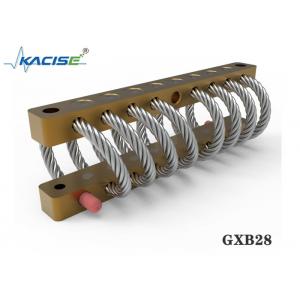

Add to Cart
Product Description
The GXB28 Series isolators are made up of helical, stranded-wire
rope held with rugged metal retaining bars.
This design provides excellent shock and vibration isolation in a
practically unlimited range of applications – vehicles, shipboard
equipment, heavy machinery, aircraft, engines, and electronic gear.
All GXB28 Series models offer specific response characteristics
based on the diameter of the wire rope, the number of strands, the
cable loop length, and the number of loops per section.
This performance is measurable and predictable for each of the
GXB28 Series sizes and configurations.
The standard GXB28 Series helical wire rope isolators are made of
stainless steel wire rope and corrosionresistant aluminum alloy
retainer bars.
Other materials including galvanized wire rope and stainless steel.
Product Size Chart
| Product number | High(mm) | Width(mm) | Product weight(kg) | Installation method | Hole size(mm) | Thread size(mm) | Counterbore taper | |
| JGX-286-8-X-16860-A-S | 191 | ± 6.35 | 210 | 11.5 | A, B, C, D, E, S | Ø13.5 + 0.13- 0.38 | M12X1.75 | 90° |
Press Fit Test Data Sheet
| Curve number | Product number | Static load(N) | Maximum deformation (mm) | Vibration stiffness Kv kN/m | Impact stiffness Ks kN/m |
| 1 | JGX-286-8-X-16860-A-S | 6540 | 102.9 | 800 | 263 |
45° Inclined Press Fitting Load Test Data Sheet
| Curve number | Product number | Static load(N) | Maximum deformation (mm) | Vibration stiffness Kv kN/m | Impact stiffness Ks kN/m |
| 1 | JGX-286-8-X-16860-A-S | 4450 | 144.8 | 448 | 131 |
Shear Rolling Load Test Data Sheet
| Curve number | Product number | Static load(N) | Maximum deformation (mm) | Vibration stiffness Kv kN/m | Impact stiffness Ks kN/m |
| 1 | JGX-286-8-X-16860-A-S | 1620 | 108 | 163 | 163 |
Wire rope vibration isolators have the following advantages:
Product structure diagram
Guide for installation of wire rope isolator
1. Before installation, please carefully check whether the mounting
hole matches the mounting hole of the vibration isolator, such as
whether the thread is the same, etc.
2, the installation hole is clean, there is no burr, rust, damage
and other defects.
3. Since the vibration isolator is an elastic component, it needs a
little movable space when working. Before installation, please
carefully check whether there is any equipment affecting
installation in the installation part and whether the movable space
of the vibration isolator is enough. Please check whether the
vibration isolator is in good condition and has no defects before
installation.
4. Prepare a suitable screwdriver and crowbar.
5, first install the isolator to heavy equipment or fixed
equipment, installation screws do not need to tighten, so that the
isolator can be slightly active.
6. Install the connecting device on the other side of the vibration
isolator. If the mounting hole is slightly misaligned, you can move
the vibration isolator or use a crowbar to align the mounting hole
of the vibration isolator with the mounting hole of the equipment,
and then screw the fixing screw.
7. After fixing the device position, tighten all the fixing screws.
Application
